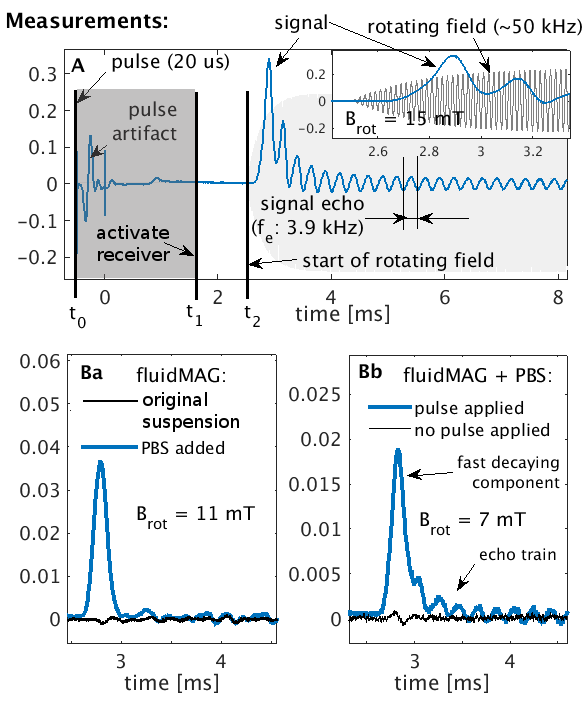Rotating Drift Spectroscopy: Generating Signal Echo Trains in Magnetic Nanoparticle Ensembles
- University of Würzburg, Experimental Physics V, Würzburg, Germany
Introduction
Magnetic particles in a rotating magnetic field show nonlinear rotational drift if the field strength is too weak to overcome the rotational friction. The resulting average rotational drift frequency strongly depends on the field strength of the magnetic field, the properties and the environment of the particle. Rotational drift was optically measured on single magnetic particles in e.g. [1] for single bacteria detection. The novel approach of Rotational Drift Spectroscopy, which is presented here, aims at measuring this nonlinear rotation in large magnetic particle ensembles in liquid suspension. A first demonstration of its biosensing capabilities is given.
Methods
The magnetization belonging to the rotational drift cancels out to zero since the corresponding magnetic moments are not locked to the rotating magnetic field. Measuring it in magnetic nanoparticle ensembles therefore requires an initial alignment of the orientation of the magnetic moments. The resulting macroscopic magnetization has a finite life time because of dephasing due to random thermal interactions and different rotational drift rates due to particle- and rotating field variations. The latter can be reversed by switching the rotating direction of the rotating field.
Results
The rotating magnetic field was generated by two orthogonal coil pairs with an amplitude up to 25 mT at about 50 kHz. Inside the receive coil and the pulse coil were located. A rotating field which periodically changes its direction of rotation, achieved by applying two slightly different frequencies to each coil pair (fCH1 = 50.3 kHz, fCH2 = 54.2 kHz), was started 3 ms after the initial pulse. By the resulting repeated rephasing of dephased magnetization a signal echo train is generated.

Fig. 1 : A shows a measurement of highly agglomerated nanoparticles (sediments of PMC-250 nm, Kisker Biotech). The maxima of the echoes show a very slow decay in this particle system. Ba compares the signal of a cationic stabilized nanoparticle suspension (fluidMAG-C 50 nm, chemicell, Germany) before and after mixing with phosphate buffered saline (PBS).
Conclusion
Rotational Drift Spectroscopy strongly depends on the particle properties and the particle environment, which makes it a highly promising tool for e.g. biosensing applications by using functionalized magnetic particles. Its capabilities can potentially be extended to high resolution imaging of magnetic particle distributions.
Acknowledgements
This work is funded by the DFG (BE 5293/1-1).
- [1] McNaughton, BH; Agayan, RR; Clarke, R; Smith, RG; Kopelman, R;, (2007), Single bacterial cell detection with nonlinear rotational frequency shifts of driven magnetic microspheres, Applied physics letters
- [2] Dieckhoff, J; Schilling, M; Ludwig, F;, (2012), Fluxgate based detection of magnetic nanoparticle dynamics in a rotating magnetic field, Applied physics letters
